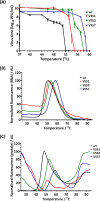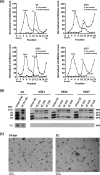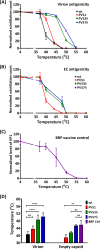Increasing Type 1 Poliovirus Capsid Stability by Thermal Selection
- PMID: 27928008
- PMCID: PMC5286869
- DOI: 10.1128/JVI.01586-16
Increasing Type 1 Poliovirus Capsid Stability by Thermal Selection
Abstract
Poliomyelitis is a highly infectious disease caused by poliovirus (PV). It can result in paralysis and may be fatal. Integrated global immunization programs using live-attenuated oral (OPV) and/or inactivated (IPV) PV vaccines have systematically reduced its spread and paved the way for eradication. Immunization will continue posteradication to ensure against reintroduction of the disease, but there are biosafety concerns for both OPV and IPV. They could be addressed by the production and use of virus-free virus-like particle (VLP) vaccines that mimic the "empty" capsids (ECs) normally produced in viral infection. Although ECs are antigenically indistinguishable from mature virus particles, they are less stable and readily convert into an alternative conformation unsuitable for vaccine purposes. Stabilized ECs, expressed recombinantly as VLPs, could be ideal candidate vaccines for a polio-free world. However, although genome-free PV ECs have been expressed as VLPs in a variety of systems, their inherent antigenic instability has proved a barrier to further development. In this study, we selected thermally stable ECs of type 1 PV (PV-1). The ECs are antigenically stable at temperatures above the conversion temperature of wild-type (wt) virions. We have identified mutations on the capsid surface and in internal networks that are responsible for EC stability. With reference to the capsid structure, we speculate on the roles of these residues in capsid stability and postulate that such stabilized VLPs could be used as novel vaccines.
Importance: Poliomyelitis is a highly infectious disease caused by PV and is on the verge of eradication. There are biosafety concerns about reintroduction of the disease from current vaccines that require live virus for production. Recombinantly expressed virus-like particles (VLPs) could address these inherent problems. However, the genome-free capsids (ECs) of wt PV are unstable and readily change antigenicity to a form not suitable as a vaccine. Here, we demonstrate that the ECs of type 1 PV can be stabilized by selecting heat-resistant viruses. Our data show that some capsid mutations stabilize the ECs and could be applied as candidates to synthesize stable VLPs as future genome-free poliovirus vaccines.
Keywords: VLP; heat stable; poliovirus.
Copyright © 2017 Adeyemi et al.
Figures









Similar articles
-
The Fight against Poliovirus Is Not Over.Microorganisms. 2023 May 17;11(5):1323. doi: 10.3390/microorganisms11051323. Microorganisms. 2023. PMID: 37317297 Free PMC article. Review.
-
Protease-Independent Production of Poliovirus Virus-like Particles in Pichia pastoris: Implications for Efficient Vaccine Development and Insights into Capsid Assembly.Microbiol Spectr. 2023 Feb 14;11(1):e0430022. doi: 10.1128/spectrum.04300-22. Epub 2022 Dec 12. Microbiol Spectr. 2023. PMID: 36507670 Free PMC article.
-
Comparative Molecular Biology Approaches for the Production of Poliovirus Virus-Like Particles Using Pichia pastoris.mSphere. 2020 Mar 11;5(2):e00838-19. doi: 10.1128/mSphere.00838-19. mSphere. 2020. PMID: 32161150 Free PMC article.
-
Production and Characterisation of Stabilised PV-3 Virus-like Particles Using Pichia pastoris.Viruses. 2022 Sep 30;14(10):2159. doi: 10.3390/v14102159. Viruses. 2022. PMID: 36298714 Free PMC article.
-
Poliovirus vaccines. Progress toward global poliomyelitis eradication and changing routine immunization recommendations in the United States.Pediatr Clin North Am. 2000 Apr;47(2):287-308. doi: 10.1016/s0031-3955(05)70208-x. Pediatr Clin North Am. 2000. PMID: 10761505 Review.
Cited by
-
The Fight against Poliovirus Is Not Over.Microorganisms. 2023 May 17;11(5):1323. doi: 10.3390/microorganisms11051323. Microorganisms. 2023. PMID: 37317297 Free PMC article. Review.
-
Inactivated Poliovirus Vaccine: Recent Developments and the Tortuous Path to Global Acceptance.Pathogens. 2024 Mar 4;13(3):224. doi: 10.3390/pathogens13030224. Pathogens. 2024. PMID: 38535567 Free PMC article. Review.
-
Structural Insight into CVB3-VLP Non-Adjuvanted Vaccine.Microorganisms. 2020 Aug 24;8(9):1287. doi: 10.3390/microorganisms8091287. Microorganisms. 2020. PMID: 32846899 Free PMC article.
-
Enteroviruses: epidemic potential, challenges and opportunities with vaccines.J Biomed Sci. 2024 Jul 15;31(1):73. doi: 10.1186/s12929-024-01058-x. J Biomed Sci. 2024. PMID: 39010093 Free PMC article. Review.
-
A Heat-Induced Mutation on VP1 of Foot-and-Mouth Disease Virus Serotype O Enhanced Capsid Stability and Immunogenicity.J Virol. 2021 Jul 26;95(16):e0017721. doi: 10.1128/JVI.00177-21. Epub 2021 Jul 26. J Virol. 2021. PMID: 34011545 Free PMC article.
References
-
- Global Polio Eradication Initiative. 2013. Polio this week; as of 31 July 2013. http://polioeradication.org.
Publication types
MeSH terms
Substances
Grants and funding
LinkOut - more resources
Full Text Sources
Other Literature Sources

